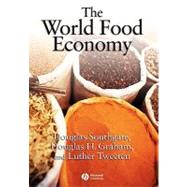
What is included with this book?
Douglas H. Graham is Professor Emeritus of Rural Finance in the Agricultural, Environmental, and Development Economics Department at Ohio State University.
Luther Tweeten is Emeritus Anderson Professor of Agricultural Marketing, Trade, and Policy in the Agriculture, Environmental, and Development Economics Department at Ohio State University. He is the author or co-author of over 500 journal articles and seven books, including Foundations of Farm Policy and Agricultural Trade: Principles and Policies.
| Preface | ix | ||||
| Acknowledgments | xii | ||||
|
1 | (9) | |||
|
4 | (3) | |||
|
7 | (3) | |||
|
9 | (1) | |||
|
10 | (31) | |||
|
11 | (5) | |||
|
16 | (9) | |||
|
25 | (3) | |||
|
28 | (3) | |||
|
31 | (2) | |||
|
33 | (8) | |||
|
34 | (1) | |||
|
34 | (7) | |||
|
41 | (33) | |||
|
42 | (7) | |||
|
49 | (13) | |||
|
62 | (4) | |||
|
66 | (8) | |||
|
67 | (1) | |||
|
68 | (6) | |||
|
74 | (24) | |||
|
76 | (2) | |||
|
78 | (5) | |||
|
83 | (3) | |||
|
86 | (12) | |||
|
89 | (1) | |||
|
89 | (9) | |||
|
98 | (26) | |||
|
99 | (3) | |||
|
102 | (7) | |||
|
109 | (10) | |||
|
119 | (5) | |||
|
123 | (1) | |||
|
124 | (23) | |||
|
125 | (3) | |||
|
128 | (4) | |||
|
132 | (3) | |||
|
135 | (7) | |||
|
142 | (5) | |||
|
143 | (1) | |||
|
143 | (4) | |||
|
147 | (19) | |||
|
148 | (7) | |||
|
155 | (3) | |||
|
158 | (3) | |||
|
161 | (3) | |||
|
164 | (2) | |||
|
165 | (1) | |||
|
166 | (21) | |||
|
166 | (1) | |||
|
167 | (3) | |||
|
170 | (6) | |||
|
176 | (7) | |||
|
183 | (4) | |||
|
185 | (2) | |||
|
187 | (19) | |||
|
187 | (4) | |||
|
191 | (7) | |||
|
198 | (4) | |||
|
202 | (4) | |||
|
205 | (1) | |||
|
206 | (22) | |||
|
207 | (3) | |||
|
210 | (2) | |||
|
212 | (8) | |||
|
220 | (5) | |||
|
225 | (3) | |||
|
227 | (1) | |||
|
228 | (22) | |||
|
228 | (5) | |||
|
233 | (4) | |||
|
237 | (5) | |||
|
242 | (6) | |||
|
248 | (2) | |||
|
248 | (2) | |||
|
250 | (23) | |||
|
251 | (3) | |||
|
254 | (4) | |||
|
258 | (7) | |||
|
265 | (7) | |||
|
272 | (1) | |||
|
272 | (1) | |||
|
273 | (22) | |||
|
274 | (4) | |||
|
278 | (3) | |||
|
281 | (7) | |||
|
288 | (5) | |||
|
293 | (2) | |||
|
294 | (1) | |||
|
295 | (26) | |||
|
296 | (6) | |||
|
302 | (4) | |||
|
306 | (7) | |||
|
313 | (5) | |||
|
318 | (3) | |||
|
319 | (2) | |||
|
321 | (36) | |||
|
324 | (5) | |||
|
329 | (8) | |||
|
337 | (8) | |||
|
345 | (9) | |||
|
354 | (3) | |||
|
355 | (2) | |||
|
357 | (13) | |||
|
360 | (4) | |||
|
364 | (2) | |||
|
366 | (4) | |||
|
369 | (1) | |||
| Abbreviations and Acronyms | 370 | (2) | |||
| Map Annex | 372 | (6) | |||
| References | 378 | (12) | |||
| Index | 390 |
The New copy of this book will include any supplemental materials advertised. Please check the title of the book to determine if it should include any access cards, study guides, lab manuals, CDs, etc.
The Used, Rental and eBook copies of this book are not guaranteed to include any supplemental materials. Typically, only the book itself is included. This is true even if the title states it includes any access cards, study guides, lab manuals, CDs, etc.